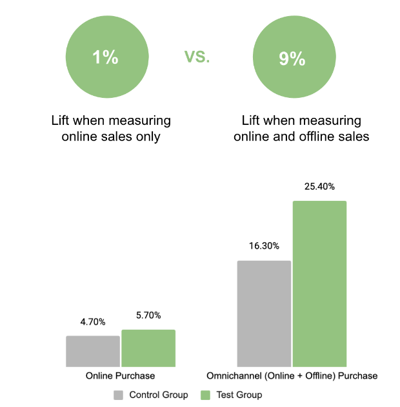5 min read
| 05 October 2023
Why Your Digital Campaign Analysis is Probably Wrong: The Importance of Omnichannel Sales Analytics
Introduction
With digital ad spend rising over 10% to $209.7 billion in 2022, the importance of effective online advertising cannot be overstated. Yet, an alarming number of businesses may be assessing their digital ad campaign's impact inadequately. At the heart of this issue is a reliance on solely online conversion metrics, ignoring a crucial piece of the puzzle: omnichannel sales.
The Rise of Omnichannel Shopping
Modern consumers no longer belong to just 'online' or 'offline' shopping camps. In fact:
- 73% of retail consumers use multiple channels to shop2
- 81% of retail shoppers conduct online research before buying in store3
This blending of online and offline shopping behavior underscores the importance of omnichannel measurement. Despite these facts, many companies rely only on online conversions to assess the impact of their digital campaigns. In fact we found that campaign analysis would be wrong 73% of the time by relying on online conversion only.

The 73% Mismatch: A Deep Dive
To understand the mismatch, we performed a meta-analysis of over 20 Purchased studies in 6 global markets from shoppers exposed to search, video, and display advertising from 2019 to 2023 in the CPG, food & beverage, and technology product categories in 6 global markets.
We looked across these studies and found that campaign effectiveness analysis would be wrong 73% of the time by relying on online conversion only. This means that for these campaigns the incorrect conclusion would potentially result in:
- Misallocation of ad budgets
- Missed opportunities to optimize ad spend
- Incorrect understanding of customer behavior
- Lost opportunities in offline sales
Let’s take a closer look at one example.
Real-world Implications: The 9% vs. 1% Lift
% of shoppers who purchased advertised brand
Purchased Channel Analysis Study (2022)

In a recent digital advertising campaign we found that online conversion showed a difference of only 1% point between test and control groups, while the inclusion of offline with online purchases revealed a 9% point lift. But how impactful is this 8% difference in real terms?
Let's illustrate this with a hypothetical scenario:
Imagine we have 100,000 shoppers exposed to the ads and the Test Ad costs $50,000. Based solely on online conversions, this ad yields a 1% increase in conversion over the control, translating to 1,000 incremental purchasers. If each of these purchasers brings in $10, the total additional revenue from the ad is $10,000. This results in a net loss of $40,000. Had the advertiser known this, they would not have run the campaign and incurred a loss.
However, by including omnichannel sales in our analysis, the Test Ad results in a surge of 9,000 incremental purchasers, generating a total of $90,000 in revenue. Subtracting the ad cost, we're left with a profit of $40,000.
This contrast underscores the importance of factoring in both online and offline sales when assessing the effectiveness of an advertising campaign.
Why Many Companies Rely Solely on Online Conversions
Given its importance, why don’t most companies use omnichannel sales to measure the impact of digital advertising campaigns? There are several reasons why many companies are still anchored to online-only conversion metrics:
- Simplicity and Instant Gratification: With a few clicks, businesses can access a treasure trove of data, from the number of clicks on an ad to the conversion rates of a landing page. But the journey to understanding true digital impact isn't as straightforward.
- Historical Siloes: Traditionally, businesses operated with separate teams for online and offline sales. This division often resulted in a distinct approach to measuring successes, with each team sticking to what they knew best. Online teams measured online conversions, and offline teams measured foot traffic and in-store purchases.
- Perceived Cost and Complexity: The integration of online and offline data can seem daunting. Many companies believe that tracking offline impact requires significant investment in tech and expertise, which might not be immediately feasible for them.
- Misconception About Digital's Influence being Limited to Online: A prevalent belief is that online campaigns primarily drive online sales, while offline marketing initiatives like TV and radio ads influence in-store purchases. Such a demarcated view can lead to an underestimation of the holistic impact of digital ads.
Moving Towards a Comprehensive Measurement Strategy
A longitudinal, omnichannel research approach to marketing attribution and analytics effectively captures omnichannel behavior (and also navigates data deprecation and restrictions). This methodology employs a 30-day experimental study on recruited shoppers in the market for a relevant category product and captures actual online and offline purchase behavior. Steps include:
- Define the Objective: Determine the specific impact or interaction you aim to study, such as "assessing an online video ad’s impact on in-store and online sales."
- Set-up Your Experiment: Create test and control groups to isolate the incremental impact of video ads for your brand's category (test group) vs video ads in an unrelated category (control group).
- Recruit Shoppers: Identify and enroll shoppers actively in the market for your product category for a 30-day study.
- Create a Realistic Digital Environment: a genuine online shopping ecosystem that replicates typical customer digital experiences and allows shoppers to organically interact with channels like search, online videos, and display ads.
- Longitudinal Tracking: Continuously track shopper interactions over 30 days, observing behavioral changes and influences revealing how various marketing touchpoints affect decisions over time.
- Capture Online and Offline Receipts for Actual Purchase Data: Shoppers submit receipts after purchases allowing confirmation of actual sales, allowing us to attribute marketing efforts to tangible outcomes.
- Analyze and Optimize: Review the collected data, pinpointing which channels or ads were most influential and use the insights to optimize your digital advertising spend.
Conclusion & Next Steps
In an era where digital ad spending has reached unprecedented heights, understanding the actual impact of these ads becomes paramount. The blended shopping habits of contemporary consumers, which seamlessly integrate online and offline channels, necessitates a shift in how we evaluate the success of our advertising campaigns. The study's findings highlight a stark disparity — with a 73% mismatch — when companies measure digital ad effectiveness by focusing solely on online conversions. This gap poses tangible risks, from misallocated budgets to lost offline sales opportunities.
Embracing a comprehensive measurement strategy, like the longitudinal, omnichannel research approach highlighted, can unravel the true impact of digital ads on consumer behavior. This method, which encompasses both online and offline behaviors over an extended period, offers businesses a clear and accurate lens through which they can view their digital marketing's ROI.
1 https://www.wsj.com/articles/digital-ad-revenue-grew-again-in-2022-but-much-more-slowly-41485957
2 https://www.invoca.com/blog/retail-marketing-statistics





